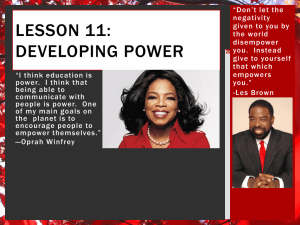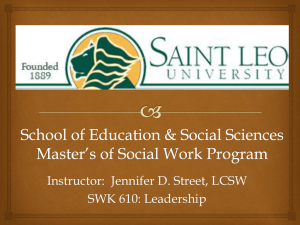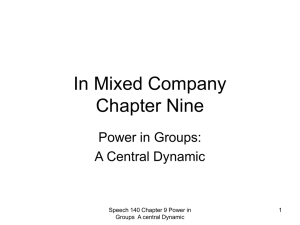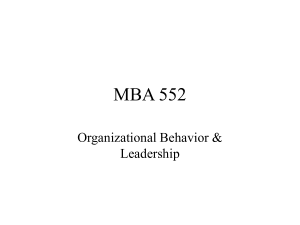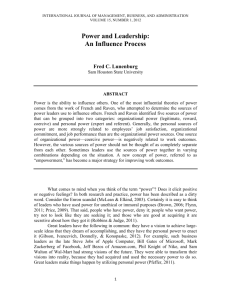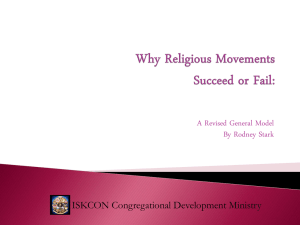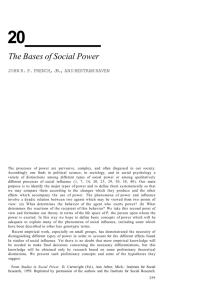Power
advertisement
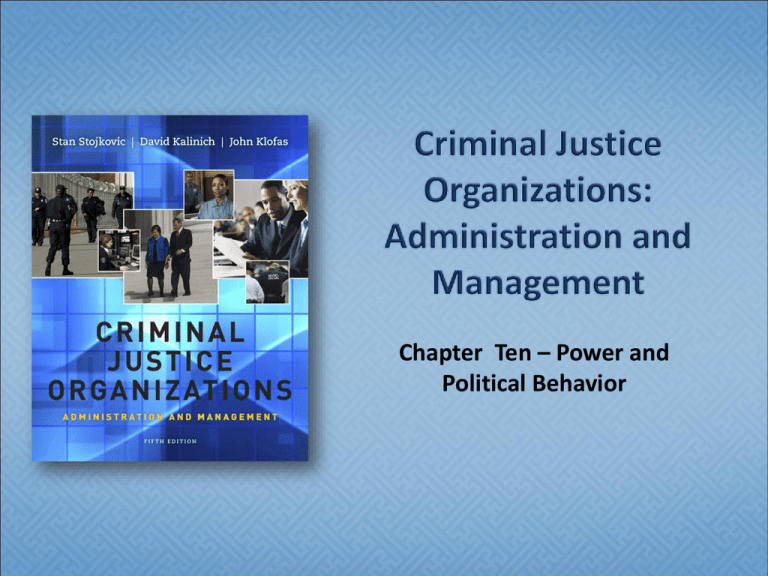
Chapter Ten – Power and Political Behavior Understand a definition of power as being both an individual construct and an organizational construct. Distinguish the various types of authority and power. Comprehend the consequences of power relations within criminal justice organizations. Grasp the importance of expressing power and political behavior among criminal justice administrators. Describe effective types of power within criminal justice agencies. Power exists in relationships. o Individuals and organizational units that are able to deal with environmental uncertainty and instability often possess more power. o In stable environments, like criminal justice organizations, power is possessed by the most efficient or effective individuals and groups. Power exists in people and the jobs they do. o Individuals or groups that cannot easily be replaced tend to be more powerful. Power resides in the individuals or groups who determine what other persons, groups or organizations do. Power relationships exist between organizational units and at the interpersonal level. Power depends on: o The ability to deal with uncertainties facing the organization, o Whether an individual or group function can easily be replaced (substitutability), and o The importance of an individual or group function to the organization’s overall mission (centrality). Terms are often used interchangeably. Difference is in the perceived legitimacy of their use. Authority is generally perceived to be a legitimate use of power. Power may be used to influence the behavior of others even without legitimate authority. Distinguished between power and authority. o Power – based on coercion, not compliance. Often used in organizations emphasizing strict obedience. o Authority – compliance with the directives necessary for achieving a common or shared goal. Weber’s Three Types of Authority o Traditional – vested in the position held by a person. o Charismatic – found in the personal attributes of a particular individual or organization. o Legal – based on the formal rules and regulations of an organization. Power exists in the interaction between the o Power holder – the person who expresses the power, and o Power recipient – the person who receives the power. Five bases of power in all organizations. o o o o o Reward – Power holder can grant remuneration. Coercive – Failure to follow orders will result in punishment. Legitimate – Power holder actually has this authority. Referent – Based on the recipient’s attraction to the holder. Expert – based on the recipient’s belief that the power holder has a high level of expertise. Power can also be acquired by individuals or groups within organizations that: o Control information in the organization (Pfeffer, 1977) o Acquire resources for the organization (Salancik and Pfeffer, 1977) Power does not exist in a vacuum. Power is contextually defined within individual and/or organizational interactions. Consequences of power relations within organization are along two dimensions: o Behavioral conformity, and o Attitudinal conformity. Types of power are not equally effective in every situation. Among inmates, Stojkovic (1984, 1986) found five types of social power. o Coercive – used by prisoners to gain ‘respect’. o Referent – power often used by religious groups. o Legitimate – rests with older and longer confined inmates. o Provision of resources – developed by inmates who are able to ‘import’ and distribute contraband. o Expert – prisoners who are knowledgeable about legal systems and case law. Social bases of power are more limited among correctional officers. Stojkovic identifies three: o Coercive o Reward o Access to information These bases of power are often eroded by: o Interactions with inmates who are themselves attempting to gain power. o Changes in the demographics of prison populations. o Changes in the way correctional officers are encouraged, or even allowed, to do their jobs. Political behavior – actions that promote individual goals over organizational goals. More likely in criminal justice organizations when o A lack of consensus among members about goals, o Disagreement over the means to achieve goals, or o Anxiety about resource allocation. Often necessary in criminal justice agencies to o Secure adequate resources through the budget process. o Seek the legal authority to respond to an emerging crime trend. o Create or recreate an organization’s mission and values statements. The political process in criminal justice agencies can be used; o Legitimately – if the agency adheres to its mission and values • To refocus the organization’s attention on an important and emerging social trend, e.g. terrorism • To define or redefine the organization’s mission and vision. o Illegitimately – if the agency departs from its mission and becomes self-serving. • When individuals within the organization use agency resources and power to satisfy their personal needs. • When the organization attempts to resist a legitimate attempt to become more relevant. Critical question – What types of power are criminal justice employees most likely to consider legitimate? o The effectiveness of power is highly dependent upon its acceptance within the organization. o Even legitimate power can be ineffective if subordinate employees disregard their leader’s legitimacy. Legitimate, charismatic and expert power are more universally accepted. Reward and coercive power can be effective if used for a legitimate purpose Reward and coercive power may lead to dysfunctional effects if used illegitimately. o Learned helplessness (psychological dependence), or o Resistance (psychological withdrawal). Power can be understood and exhibited at both the individual and organizational levels. Power and authority are not the same thing. Weber identifies three types of power – traditional, charismatic and legal. French and Raven identify five types of power – coercive, reward, legitimate, referent and expert. Other researchers include the control of information and access to resources as sources of power. Power relationships within organizations can be defined along two dimensions – behavioral conformity and attitudinal conformity. Different expressions of power will have different impacts on organizations. There is a relationship between legitimacy and political behavior in criminal justice organizations. The political process is not inherently bad for criminal justice administrators. In fact, in many cases the political process is how things get done in criminal justice organizations. While driving home one evening the District Attorney of a rural Midwestern county is injured when his vehicle strikes a deer. This is the third time this DA has hit a deer on the roadway. He decides that the excessive deer population in his county is a threat to public safety. His appeals to the state wildlife agency for assistance (increasing the hunting limits) are unanswered. The following week the DA issues a press release informing the public that his office will no longer accept poaching cases involving deer. Because game poaching cases must be prosecuted by his office, this action effectively eliminates deer hunting limits in his county. Does the District Attorney have the power or authority to make this decision? What type of power or authority is the District Attorney exercising? Given what you know about the consequences of power, what are the possible effects of the District Attorney’s actions?
